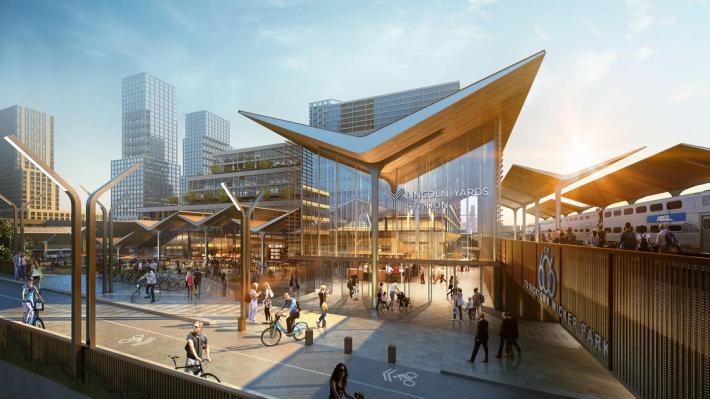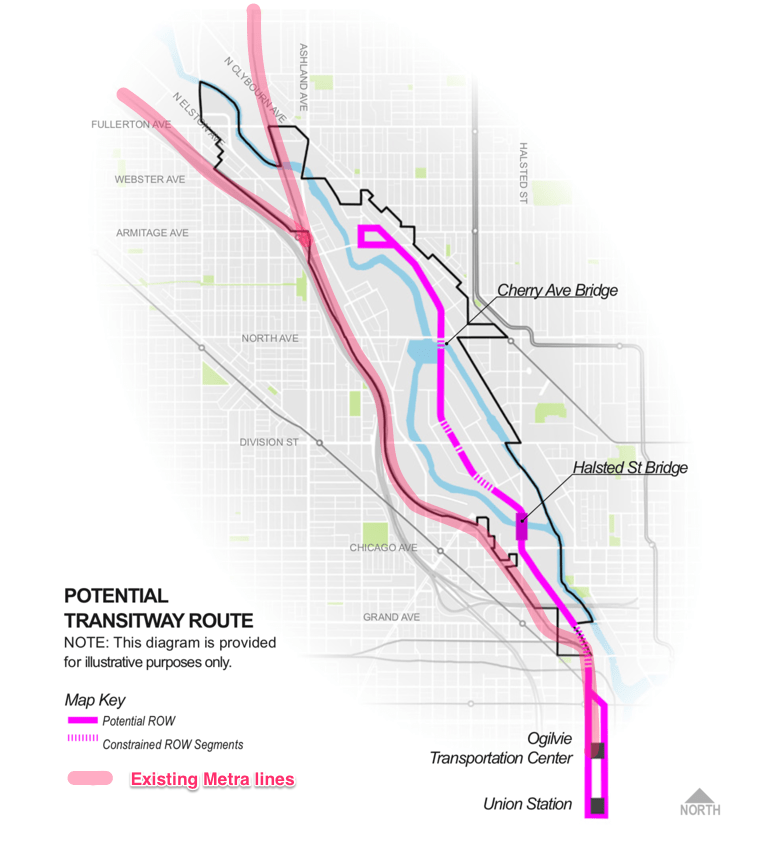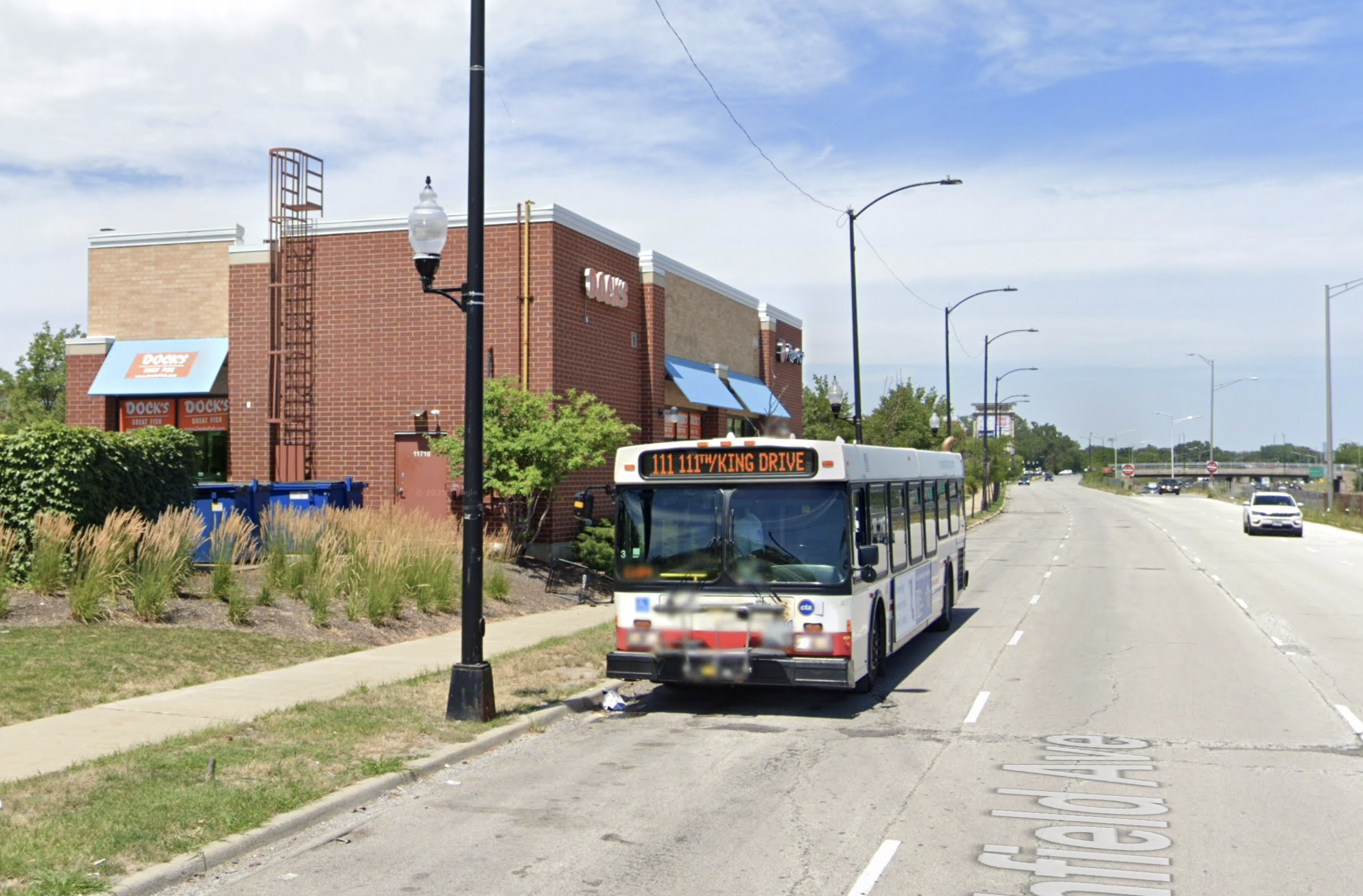Last year the Chicago Department of Planning and Development recommended creating a new transitway that between Goose Island and downtown Chicago. The recommendation, developed as part of the North Branch Framework Plan, seems to be evolving into a concrete proposal, since the DPD has acknowledged in the media that it has been in talks with Lincoln Yards developer Sterling Bay about the possibilty of a light rail route or bus-only lanes. (Lincoln Yards will occupy land along the north branch of the Chicago River that was vacated by Finkl Steel, General Iron, and Lakin Recycling in recent years.)
The transitway would also include a bike and pedestrian trail. Increasing transit access and capacity in the area might become necessary if Sterling Bay's plans to build lots of housing and offices comes to fruition, or if Amazon chooses to locate there.
If any new transit mode is built here, it should be a robust bus rapid transit corridor with enforced car-free lanes, limited stops, prepaid, level boarding, and traffic signal prioritization, something that doesn't yet exist in Chicago. Light rail lines are much more expensive than BRT, and light rail lines that have their own right-of-way (rather than being slowed down by car traffic) are even more expensive.
The Chicago Tribune published a map of the possible transitway alignment, using information from DPD's plan. Notably, the map omitted the existing two commuter rail lines – Metra's UP-North and UP-Northwest – that run just west of the proposed route between Armitage Avenue and the Ogilvie Transportation Center via the Clybourn station.
It appears that the city isn't seriously considering the possibility of implementing rapid transit-style service on those two Metra lines as an alternative for transporting future residents from the North Branch Industrial Corridor (an area larger than Goose Island) to downtown workplaces, or vice versa. (Goose Island isn't zoned for residential uses.) According to the plan, the purpose of the new transitway would be "to increase connectivity with the central business district as well as to other transit modes." The two Metra lines do that already, although service is infrequent, except for inbound morning rush-hour commutes and outbound trips during the evening rush, so ignoring the possibility of rapid service on these routes represents a missed opportunity.
The failure of the Rahm Emanuel administration to pitch in to improve Metra service as a strategy for boosting transit access for Chicagoans is a recurring issue. The city's plan for the $2.3 billion CTA Red Line extension to 130th Street largely ignores the fact that similar results could be achieved much cheaper and faster if the CTA collaborated with Metra to create rapid transit service on the nearby Metra Electric District line.
In addition, the city of Chicago doesn't invest any money in building or rehabbing Metra stations, even though 29 percent of Metra's stations are located within the city limits. In contrast, Emanuel has invested nearly half a billion dollars in federal and local funds to rehab CTA stations, and used has $100 million in city funds to build two new stations, and is spending $60 million in to construct a new Green Line station at Lake and Damen, largely funded by tax-increment financing money.
Emanuel's indifference to improving Metra service may be due to the fact that while he has political control over the CTA, he only gets to appoint one out of ten Metra board members, as well as the fact that most Metra commuters don't live in the city, so he doesn't have to worry about winning their votes. But increasing Metra service and frequency could provide new transportation options for hundreds of thousands of Chicagoans on all sides of the city where the 'L' doesn't exist, so that would be savvy politics as well as good for the people.
Meanwhile, Metra proposed a station at Peterson and Ravenswood avenues in 2013, and was still intending to build it as of 2016, but can't move forward with the project due to a $15 million funding shortfall. As of December 2016 the Clark/Ridge TIF district, which covers the station area had about $18 million in unallocated money. Emanuel controls TIF funding so, as with the Lake/Damen stop, he could allocate that cash if he wanted to. But the mayor hasn't shown much interest in doing so, presumably because the Peterson facility would be a Metra stop, rather than a CTA station.

Sterling Bay has included a relocated Clybourn Metra station in its own plan and renderings for Lincoln Yards. R2 Companies, another developer that owns a lot of property on Goose Island, proposed building new bike and pedestrian bridges to facilitate trips between the island and the Chicago Blue Line station and the North/Clybourn Red Line station two years ago. DPD's Framework Plan acknowledges the possibility of building those bridges.






